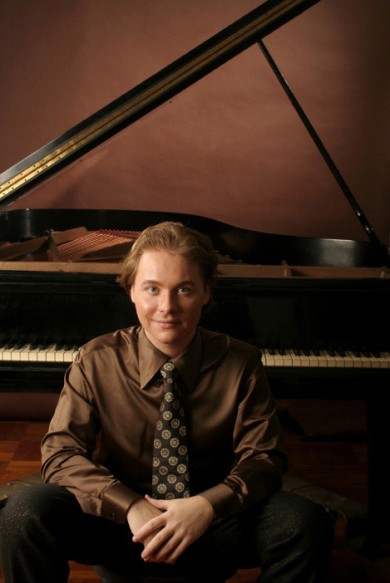Brooding Sibelius and showy Rachmaninoff highlight Miami Symphony program

Konstantin Soukhovetski performed Rachmaninoff’s Piano Concerto No. 3 Sunday night with Eduardo Marturet and the Miami Symphony Orchestra.
Although the audience stood up and cheered for a performance of a virtuoso piano concerto, the most compelling performance of the Miami Symphony Orchestra’s opening night concert may be have been in the subtler, more richly textured tones of a Sibelius symphony.
The concert Sunday at the Arsht Center opened with Rachmaninoff’s Piano Concerto No. 3, a famously finger-busting work that practically makes the floor shake with its dramatics, performed by the Russian-born pianist Konstantin Soukhovetski. He appeared to have little difficulty with the concerto’s rapid, fistfuls of notes. If he lacked the edge of nervous excitement that can really put this work over, his smooth, fluid playing brought out its romantic colors. In the opening of the first movement, he played effectively under the orchestra’s melodic passages, his effortless virtuosity allowing the piano to be heard without detracting from the themes in the orchestra.
Any pianist who fails to play a few wrong notes in the Rachmaninoff Third is probably playing too carefully, and Soukhovetski hit a few clunkers. But in general he conquered the work’s formidable technical hurdles with apparent ease. The orchestra, conducted by Eduardo Marturet, did a fine job carrying a lot of the melodic weight, with particularly good work by principal horn Hector Rodriguez, whose assertive, rich tone made the most of Rachmaninoff’s melodies. But the climax of the third movement, one of those great Rachmaninoff moments when the melody soars in piano, strings and brass, was blown by an over-assertive horn section that covered up the theme.
As an encore, Soukhovetski performed his own arrangement of a Johann Strauss song, a gently lyric contrast to the Rachmaninoff.
Sibelius’s Symphony No. 7, the composer’s last, is a compact one-movement work that covers a tremendous amount of musical and emotional territory in its short length. Under Marturet’s baton and with precise, richly textured playing by the orchestra, the symphony was a compelling musical journey from the ambiguous, shadowy opening to its hopeful conclusion.
In the first section, Marturet led the orchestra through the dark harmonies of the opening through a crescendo to a great, major-key statement of affirmation. The orchestra played with a high degree of polish, winds and strings glinting in the inky chords of the work’s middle section. Brass delivered a weighted, gleaming performance in a series of rising chords performed over a running figure in the strings. Marturet guided the orchestra through a glowing performance of the chords with which it ends.
The program closed with the Hungarian composer Zoltán Kodály’s Dances of Galanta, a showy work based on melodies from northern Hungary. Alternately meditative, manic and wistful in the stereotypical Hungarian manner, the work requires virtuoso playing from the orchestra, and the Miami players delivery a fiery, evocative performance. Clarinetist Nuno Antunes brought a rounded, buttery tone to his solos, playing with an improvisatory freedom. Violins executed rapid runs with dash and style. Tunes bounced from instrument to instrument through the work, and Marturet gave the musicians the interpretive room to make the most of its freewheeling melodies.
Posted in Uncategorized
5 Responses to “Brooding Sibelius and showy Rachmaninoff highlight Miami Symphony program”
Leave a Comment
Mon Oct 22, 2012
at 11:52 am
5 Comments







Posted Oct 23, 2012 at 8:28 am by Fred Jonas
I certainly agree with Fleshler’s “technical” review of the concert, and it was an important part of the experience, but it’s nearly beside the point. This concert was fun. It was stimulating. It was unique. The audience was drawn in in a way that doesn’t happen in concerts like this. They were conversed with by the conductor and the musicians, given some interesting heads ups about the music. They were invited to clap between movements. They were seduced by Marturet, and by the accessibility of the musicians. This concert was a very welcoming place to be. And as Fleshler says, the technical aspects get a big A+. I’m glad I have a season ticket, and eight more concerts this year, and sorry one is now already gone.
Posted Oct 23, 2012 at 11:22 am by George Teichholz
I enjoyed the concert in its entirety. Special mention to the Sibelius which I thought was absolutely beautiful. The Rachmaninoff#3 is always great to hear and discover its nuances. I had never heard the Kodály but it was equally beautiful. In summation, the Miami Symphony was exciting and it sound was crisp and clear. It deserves to stay alive and well, and the haves and have mores should invest in this orchestra. Miami is rich in sports, poor in art. And an orchestra is a mark of culture in a city. So guys. invest in the Miami Symphony; it’s a worthwhile cause for Miami and the musical culture of this city.
Posted Oct 28, 2012 at 7:37 pm by hector
So amusing and funny! I play just right! 😉 Chicago knows, Tokyo knows, Firenze knows… No more, no less… 😉 We’re enjoying our vacation in the Caribbean now reading this, haha, and enjoying every bit of it 🙂 hahaha!!
Posted Oct 28, 2012 at 8:20 pm by Hector
Do you post only comments beneficial to you? So funny and lousy… Hahaha. Post them all man, if you think you are “that good” hahaha… 😉 Cheers! H
Posted Nov 24, 2012 at 10:26 am by Pedro
Who is this silly guy with the “I play just right! Chicago knows, Tokyo knows, Firenze knows” are you serious? You are annoying with the happy faces and such, this a review, not Facebook.